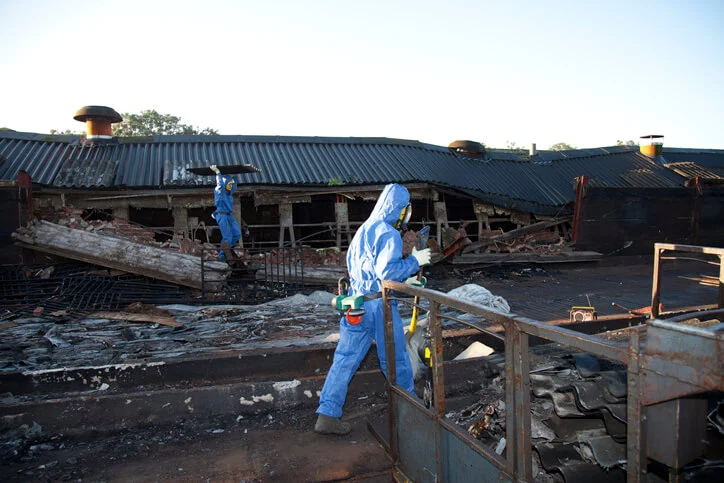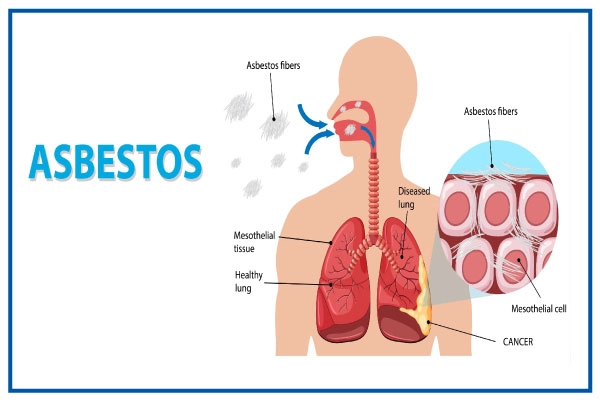Phone:
720-399-3335
Office address:
1685 S. Colorado Blvd. Suite 151, Denver, CO 80222

We’re no strangers to the silent yet potent hazards that lurk within our buildings, specifically the menace of asbestos. Asbestos, once hailed for its heat resistance and durability, has now been linked to serious health issues such as lung cancer and mesothelioma.
But how can we safeguard our health and the health of our loved ones from these unseen threats? Our discussion will examine the ways to identify potential asbestos in buildings, engage professionals for inspection and testing, and understand the safe techniques for its removal.
So, let’s begin on this journey, and reveal the tools we need to keep our spaces safe and asbestos-free.
Key Takeaways

Grasping the nature and hazards of asbestos is the first essential step in shielding ourselves from its detrimental health effects. Originating from the asbestos history, we’ve learned that it’s a naturally occurring mineral employed for its strength and fire resistance in a variety of products, from insulation to automotive brakes. However, its use has been curtailed markedly due to its health implications.
When disturbed, asbestos releases tiny fibres into the air. When we breathe them in, they can become trapped in our lungs, leading to severe health conditions. The most common include asbestosis, a chronic lung disease causing shortness of breath and a persistent cough, and mesothelioma, a rare and aggressive form of lung cancer.
It’s vital to understand that asbestos doesn’t present a risk if it’s in good condition and left undisturbed. The danger comes when it’s damaged or disturbed, releasing those harmful fibres. We’re not always aware of its presence, and even less often aware of its condition, which is why understanding asbestos and its dangers is key to our protection. Armed with this knowledge, we’re better equipped to protect our health and environment.
Now that we’re familiar with the dangers of asbestos, let’s turn our attention to how we can identify potential asbestos in our buildings.
First off, it’s important to know that buildings constructed or renovated before the 1980s may contain asbestos materials. These can be found in insulation, tiles, plaster, and even heating systems. We can’t identify asbestos just by looking, so we need to be aware of the places it may hide.
Asbestos legislation is vital to our understanding. Certain laws regulate the handling and removal of asbestos, ensuring our safety. This legislation also provides guidelines on what to do when we suspect asbestos presence.
Health screening is another tool we can use. Regular checks can help to detect asbestos-related health issues early on. Symptoms such as shortness of breath, persistent cough, and chest pain are red flags we mustn’t ignore.
However, we should never attempt to remove or disturb suspected asbestos ourselves. This can release dangerous fibers into the air, posing a health risk. Instead, if we suspect the presence of asbestos, it’s best to leave the area undisturbed and inform a professional immediately.
Call Now
You Can Call Us At This Number: 720-399-3335
When it comes to guaranteeing our safety from potential asbestos exposure, seeking the help of professional asbestos inspection and testing services is an important step we can’t afford to skip. These professionals are trained to identify and assess the risk posed by asbestos in our homes, workplaces, and other buildings. They come armed with specialized equipment and knowledge to locate and test materials suspected of containing asbestos.
Inspection costs can vary widely depending on the size and complexity of the property. It’s well worth the investment, though, considering the health risks associated with asbestos exposure. Generally, a thorough inspection can cost anywhere from a few hundred to several thousand dollars.
Equally important as the inspection is the certification of the professionals conducting it. Certification importance can’t be overstated. This certification ensures that the professional has completed rigorous training and has the necessary qualifications to safely and effectively inspect for asbestos. It’s our guarantee that they’ll adhere to strict safety standards and procedures to protect us from unnecessary exposure.
After securing a professional asbestos inspection and ensuring the inspectors are certified, the next step we should consider is the application of safe asbestos removal techniques. Protection equipment usage is important in this process. We must wear disposable coveralls, gloves, and proper respiratory protection to prevent inhalation of asbestos fibers.
We’ve got to seal off the work area to avoid contamination of other spaces. It’s important to wet the asbestos materials with water, which reduces the release of fibers. Always avoid breaking the materials into small pieces as it increases the chance of airborne asbestos particles.
Our disposal methods also play a significant role in safe asbestos removal. We should carefully seal the removed asbestos in leak-tight containers or bags. It’s important not to overfill the bags, and they should be clearly labeled as hazardous waste. Following this, we should promptly transport the waste to a designated disposal site following local regulations to ensure safety for everyone.
In the quest to maintain a safe and healthy environment, we must continuously manage the risks associated with asbestos, even after its safe removal. The key to ongoing asbestos risk management is a thorough risk assessment and employee training.
Through risk assessment, we can: – Identify areas where asbestos might still be present. – Evaluate the potential risk of exposure. – Develop a plan to manage that risk. – Regularly review and update the assessment.
Employee training is equally essential. Everyone in a workplace where asbestos may be present should be trained in asbestos awareness. This includes understanding what asbestos is, where it might be located, and the health risks associated with exposure. They should also be trained in procedures to follow if they suspect they’ve been exposed.
We’re well-versed with asbestos legislation’s impact. If exposed, people can pursue a compensation claim process. They’re entitled to seek damages for health issues stemming from asbestos exposure, ensuring their legal rights are robustly respected.
We’re unsure how our bodies react to asbestos or how long symptoms take to appear. However, we’re certain that asbestos detection methods and exposure prevention strategies can greatly reduce risk and safeguard our health.
We’re exploring treatment options for asbestos-related diseases. Key factors include disease progression and asbestos detection. We’d focus on timely diagnosis, aggressive therapies, and potentially, experimental treatments within clinical trials to combat these serious health conditions.
Yes, we’ve found several lifelines. Asbestos Compensation Schemes offer financial relief to sufferers. Additionally, Insurance Coverage Options exist that can lighten the load of asbestos-related healthcare costs. It’s worth exploring these avenues.
We’re aware that jobs like construction, shipbuilding, and firefighting are at high risk for asbestos exposure. Asbestos management strategies and personal protective equipment usage can greatly decrease these risks.
In wrapping up, we can’t stress enough the gravity of taking asbestos-related health risks seriously. It’s a matter of life or death!
By identifying potential asbestos, getting professional inspections, using safe removal techniques, and managing risks, we can effectively keep these hazards at bay.
Don’t let asbestos make your home a ticking time bomb. Stay informed, stay safe, and let’s keep our homes and workplaces asbestos-free.
Call Now
You Can Call Us At This Number: 720-399-3335